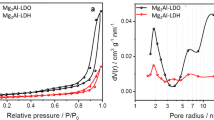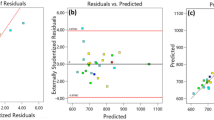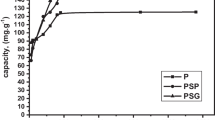Abstract
By means of a molecular-level theory we investigate glyphosate adsorption from aqueous solutions to surface-grafted poly(allylamine) layers. Our molecular model of glyphosate and the polymeric material includes description of size, shape, conformational freedom, and state of protonation of both components. The composition of the bulk solution (pH, salt concentration and glyphosate concentration) plays a critical role to determine adsorption. Adsorption is a non-monotonic function of the solution pH, which can be explained in terms of the pH-dependent protonation behavior of both adsorbate and adsorbent material. Lowering the solution salinity is an efficient way to enhance glyphosate adsorption. This is because glyphosate and salt anions compete for adsorption to the polymer layer. In this competition, glyphosate deprotonation, to increase its negative charge upon entering the polymer layer, plays an critical role to favor its adsorption under a variety of solution conditions. This deprotonation is the result of the higher pH that establishes inside the polymer. Our results show that such pH increase can be controlled, while achieving significant glyphosate adsorption, through varying the grafting density of the material. This result is important since glyphosate degradation by microbial activity is pH-dependent. These polymeric systems are excellent candidates for the development functional materials that combine glyphosate sequestration and in situ biodegradation.








Similar content being viewed by others
References
Becke, A.D.: Density-functional thermochemistry. III. The role of exact exchange. J. Chem. Phys. 98(7), 5648–5652 (1993)
Benbrook, C.M.: Trends in glyphosate herbicide use in the United States and globally. Environ. Sci. Eur. 28(1), 1–15 (2016)
Burella, P., Odetti, L., Simoniello, M., Poletta, G.: Oxidative damage and antioxidant defense in caiman latirostris (broad-snouted caiman) exposed in ovo to pesticide formulations. Ecotoxicol. Environ. Saf. 161, 437–443 (2018)
Castro Berman, M., Marino, D.J., Quiroga, M.V., Zagarese, H.: Occurrence and levels of glyphosate and AMPA in shallow lakes from the Pampean and Patagonian regions of Argentina. Chemosphere 200, 513–522 (2018)
Chamberlain, K., Evans, A.A., Bromilow, R.H.: 1-octanol/water partition coefficient (kow) and pka for ionisable pesticides measured by a ph-metric method. Pestic. Sci. 47(3), 265–271 (1996)
Flory, P.J.: Statistical Mechanics of Chain Molecules. Interscience, New York (1969)
Frisch, M., Trucks, G., Schlegel, H., Scuseria, G., Robb, M., Cheeseman Jr., J., Vreven, T., Kudin, K., Burant, J., Millam, J., Iyengar, S., Tomasi, J., Barone, V., Mennucci, B., Cossi, M., Scalmani, G., Rega, N., Petersson, G., Nakatsuji, M., Pople, J.: Gaussian 03, Revision B.03. Gaussian, Inc., Pittsburgh (2003)
Gong, P., Genzer, J., Szleifer, I.: Phase behavior and charge regulation of weak polyelectrolyte grafted layers. Phys. Rev. Lett. 98, 018302 (2007)
Guo, L., Cao, Y., Jin, K., Han, L., Li, G., Liu, J., Ma, S.: Adsorption characteristics of glyphosate on cross-linked amino-starch. J. Chem. Eng. Data 63(2), 422–428 (2018)
Hallas, L.E., Adams, W.J., Heitkamp, M.A.: Glyphosate degradation by immobilized bacteria: field studies with industrial wastewater effluent. Appl. Environ. Microbiol. 58(4), 1215–1219 (1992)
Kohn, W., Sham, L.J.: Self-consistent equations including exchange and correlation effects. Phys. Rev. 140(4A), 1133–1138 (1965)
la Cecilia, D., Maggi, F.: Analysis of glyphosate degradation in a soil microcosm. Environ. Pollut. 233, 201–207 (2018)
Lan, H., He, W., Wang, A., Liu, R., Liu, H., Qu, J., Huang, C.P.: An activated carbon fiber cathode for the degradation of glyphosate in aqueous solutions by the electro-fenton mode: optimal operational conditions and the deposition of iron on cathode on electrode reusability. Water Res. 105, 575–582 (2016)
Lee, C., Yang, W., Parr, R.G.: Development of the Colle-Salvetti correlation-energy formula into a functional of the electron density. Phys. Rev. B 37(2), 785–789 (1988)
Liu, Z., Zhu, M., Yu, P., Xu, Y., Zhao, X.: Pretreatment of membrane separation of glyphosate mother liquor using a precipitation method. Desalination 313, 140–144 (2013)
Loperena, L., Ferrari, M.D., Saravia, V., Murro, D., Lima, C., Ferrando, L., Fernández, A., Lareo, C.: Performance of a commercial inoculum for the aerobic biodegradation of a high fat content dairy wastewater. Bioresour. Technol. 98(5), 1045–1051 (2007)
Lopes, F.M., Sandrini, J.Z., Souza, M.M.: Toxicity induced by glyphosate and glyphosate-based herbicides in the zebrafish hepatocyte cell line (zf-l). Ecotoxicol. Environ. Saf. 162, 201–207 (2018)
Manogaran, M., Shukor, M.Y., Yasid, N.A., Johari, W.L.W., Ahmad, S.A.: Isolation and characterisation of glyphosate-degrading bacteria isolated from local soils in Malaysia. Rendiconti Lincei 28(3), 471–479 (2017)
Martinez, D.A., Loening, U.E., Graham, M.C.: Impacts of glyphosate-based herbicides on disease resistance and health of crops: a review. Environ. Sci. Eur. 30(1), 2 (2018)
Nap, R., Gong, P., Szleifer, I.: Weak polyelectrolytes tethered to surfaces: effect of geometry, acid-base equilibrium and electrical permittivity. J. Polym. Sci. Part B Polym. Phys. 44(18), 2638–2662 (2006)
Pérez-Mitta, G., Marmisollé, W.A., Albesa, A.G., Toimil-Molares, M.E., Trautmann, C., Azzaroni, O.: Phosphate-responsive biomimetic nanofluidic diodes regulated by polyamine-phosphate interactions: Insights into their functional behavior from theory and experiment. Small 14, 1702131 (2018)
Primost, J.E., Marino, D.J., Aparicio, V.C., Costa, J.L., Carriquiriborde, P.: Glyphosate and ampa,“pseudo-persistent” pollutants under real-world agricultural management practices in the mesopotamic pampas agroecosystem, argentina. Environ. Pollut. 229, 771–779 (2017)
Rendon-von Osten, J., Dzul-Caamal, R.: Glyphosate residues in groundwater, drinking water and urine of subsistence farmers from intensive agriculture localities: a survey in Hopelchén, Campeche, Mexico. Int. J. Environ. Res. Public Health 14(6), 595 (2017)
Ronco, A.E., Marino, D.J., Abelando, M., Almada, P., Apartin, C.D.: Water quality of the main tributaries of the Paraná basin: glyphosate and AMPA in surface water and bottom sediments. Environ. Monit. Assess. 188(8), 458 (2016)
Santos, T.R.T., Andrade, M.B., Silva, M.F., Bergamasco, R., Hamoudi, S.: Development of \(\alpha\)- and \(\gamma\)-Fe2O3 decorated graphene oxides for glyphosate removal from water. Environ. Technol. 3330, 1–20 (2017)
Sharma, A., Jha, P., Reddy, G.V.: Multidimensional relationships of herbicides with insect-crop food webs. Sci. Total Environ. 643, 1522–1532 (2018)
Song, J., Li, X.M., Figoli, A., Huang, H., Pan, C., He, T., Jiang, B.: Composite hollow fiber nanofiltration membranes for recovery of glyphosate from saline wastewater. Water Res. 47(6), 2065–2074 (2013)
Soracco, C.G., Villarreal, R., Lozano, L.A., Vittori, S., Melani, E.M., Marino, D.J.: Glyphosate dynamics in a soil under conventional and no-till systems during a soybean growing season. Geoderma 323, 13–21 (2018)
Woodburn, A.T.: Glyphosate: production, pricing and use worldwide. Pest Manag. Sci. 56(4), 309–312 (2000)
World Health Organization: glyphosate and AMPA in drinking-water. Technical Report. World Health Organization (2005)
Xing, B., Chen, H., Zhang, X.: Efficient degradation of organic phosphorus in glyphosate wastewater by catalytic wet oxidation using modified activated carbon as a catalyst. Environ. Technol. 39(6), 749–758 (2018)
Younes, M., Galal-Gorchev, H.: Pesticides in drinking water-A case study. Food Chem. Toxicol. 38, S87–S90 (2000)
Yu, X., Yu, T., Yin, G., Dong, Q., An, M., Wang, H., Ai, C.: Glyphosate biodegradation and potential soil bioremediation by Bacillus subtilis strain bs-15. Genet. Mol. Res. 14(4), 14717–14730 (2015)
Zavareh, S., Farrokhzad, Z., Darvishi, F.: Modification of zeolite 4A for use as an adsorbent for glyphosate and as an antibacterial agent for water. Ecotoxicol. Environ. Saf. 155, 1–8 (2018)
Zhou, C., Jia, D., Liu, M., Liu, X., Li, C.: Removal of glyphosate from aqueous solution using nanosized copper hydroxide modified resin: equilibrium isotherms and kinetics. J. Chem. Eng. Data 62(10), 3585–3592 (2017)
Acknowledgements
This work was supported by CONICET and ANPCyT (Grant No. PICT-2014-3377), Argentina. N. A. P. C. acknowledges a ANPCyT fellowship (Grant No. PICT-2015-3425).
Author information
Authors and Affiliations
Corresponding author
Additional information
Publisher's Note
Springer Nature remains neutral with regard to jurisdictional claims in published maps and institutional affiliations.
Appendix
Appendix
1.1 Theoretical approach
In this section, we give expressions for the different contributions to the free energy, Eq. (1). The first term in the right-hand side of that equation contains the conformational entropy of the polymer layer,
where \(P(\alpha )\) is the probability of finding a polymer chain in its conformation \(\alpha\), \(k_B\) is the Boltzmann constant, and N is the number of chains grafted to the surface of total area A.
In the second contribution to the free energy, the translational (mixing) entropy of mobile species (except glyphosate) is
where the subindex \(\gamma\) runs over water molecules (w), hydronium (\(H^+\)) and hydroxyde ions (\(OH^-\)), salt cations (\(+\)) and anions (−); \(\rho _{\gamma }(z)\) gives the local number density of the corresponding species; \(\nu _w\) is the volume of a water molecule, and \(\beta =\frac{1}{k_BT}\). This contribution also includes the standard chemical potential (self-energies) of each of these free species, \(\mu ^{0}_{\gamma }\).
The translational and configurational (rotational) entropy of the glyphosate molecule is
where \(\rho _{gly}(\alpha _{gly},z)\) is the local density of glyphosate in conformation \(\alpha _{gly}\). This contribution also contains the self-energy of the molecule, given by its standard chemical potential \(\mu _{gly}^{0}\). Then, the total density of glyphosate at z is
where 〈〉 indicate ensemble average over molecular conformations.
Next term in Eq. (1) is the chemical free energy that describes the acid-base equilibrium of PAH units. This contribution can be expressed as
where \(f_{AH}(z)\) is the local degree of charge (or protonation) of PAH units, and \(\left\langle \rho (z)\right\rangle\) is the ensemble average density of segments belonging to a single chain, such that
with \(\rho (\alpha , z)\) being the local density of segments of a chain in conformation \(\alpha\). In Eq. (9), \(\mu ^{0}_{AHp}\) and \(\mu ^{0}_{AHd}\) are the standard chemical potentials of the protonated and deprotonated unit, respectively. These quantities are related to the thermodynamic equilibrium constant, \(K^0_{AH}\), through the following equation:
The chemical free energy of glyphosate, which accounts for the acid-base equilibria of its titratable units is
where \(\tau\) runs over the different titratable units of glyphosate, which are the diacidic phosphonate group, the carboxylate group and the amine group (\(\tau =php_1,php_2,cbx,amn\)); the standard chemical potentials of these units are \(\mu ^{0}_{\tau p}\) and \(\mu ^{0}_{\tau d}\) for the protonated and deprotonated unit, respectively. The local degree of protonation of \(\tau\) units is \(g_\tau (z)\). In the case of the amine group, this quantity is equal to its local degree of charge \(f_{amn}(z)\), while for the acidic units \(f_\tau (z)=1-g_\tau (z)\) (with \(\tau =php_1,php_2,cbx\)). In addition, the local density of glyphosate units can be expressed as:
where \(n_\tau (\alpha _{gly},z',z)\) is the number (density) of units type \(\tau\) that a glyphosate molecule with center of mass at \(z'\) contributes to z.
The next term in Eq. (1) is \(U_{ste}\), which describes the steric repulsions at the excluded volume level. This contribution is incorporated through requiring each element of volume to be fully occupied by some of the chemical species. This constraint to the the free energy can be expressed as:
where \(\nu _{AH}\) is the volume of a PAH segment, \(\nu _\gamma\) is that of free species \(\gamma\), and \(\nu _\tau\) the volume of glyphosate unit \(\tau\).
The last contribution to F is the electrostatic energy,
where \(\epsilon\) is the medium permittivity, and \(\psi (z)\) is the position-dependent electrostatic potential. In this equation, the local density of charge is
\(q_{AH}\), \(q_\gamma\) and \(q_\tau\) are the electric charges of the different species.
This system is in equilibrium with a bulk solution of controlled composition, which fixes the chemical potentials of all free species (\(\mu _\gamma\) and \(\mu _{gly}\)). Under these conditions, the proper thermodynamic potential whose minimum yields equilibrium is the semi-grand potential, which can be written as
where \(N_\gamma\) and \(N_{gly}\) are the corresponding number of molecules.
With all these expressions for its different contributions, the grand potential can expressed in terms of integrals and configurational sums the following functions:
-
(i)
\(P(\alpha );\)
-
(ii)
\(\rho _{w}(z), \,\rho _{H^{+}}(z),\, \rho _{OH^{-}}(z),\, \rho _{+}(z),\, \rho _{-}(z),\rho _{gly}(\alpha _{gly},z);\)
-
(iii)
\(f_{AH}(z),\,f_{php_1}(z),\, f_{php_2}(z),\, f_{amn}(z),\, f_{cbx}(z);\)
-
(iv)
\(\psi (z).\)
Optimization of \(\Omega\) with respect to functions (i) to (iii) leads to expressions for these functions that only depend on the two interaction potentials: \(\psi (z)\) and \(\pi (z)\), which is the Lagrange multiplier introduced to enforce satisfaction of the incompressibility constraint, Eq. (14). The extremum of \(\Omega\) with respect to the electrostatic potential results in the Poisson equation:
Finally, \(\psi (z)\) and \(\pi (z)\) are obtained though iteratively solving the Poisson equation (Eq. (18)) and the incompressibility constraint (Eq. (14)) at each position. Once these interaction potentials have been calculated, functions (i) to (iv) are known, and consequently the free energy of the system is determined.
Rights and permissions
About this article
Cite this article
Pérez-Chávez, N.A., Albesa, A.G. & Longo, G.S. Molecular theory of glyphosate adsorption to pH-responsive polymer layers. Adsorption 25, 1307–1316 (2019). https://doi.org/10.1007/s10450-019-00091-9
Received:
Revised:
Accepted:
Published:
Issue Date:
DOI: https://doi.org/10.1007/s10450-019-00091-9




